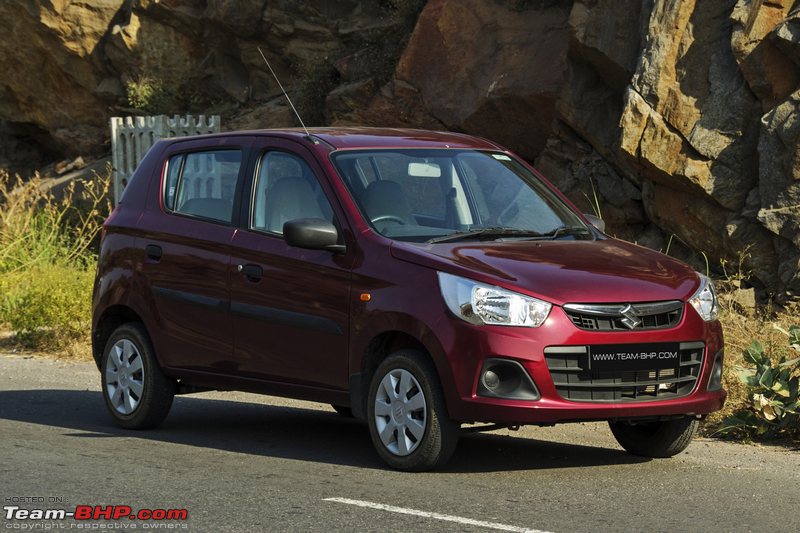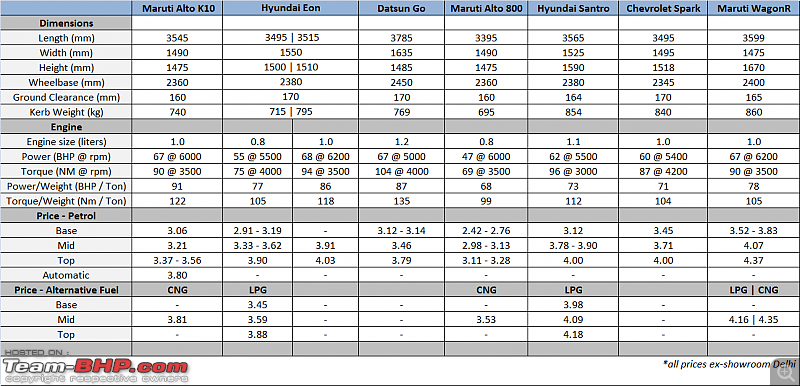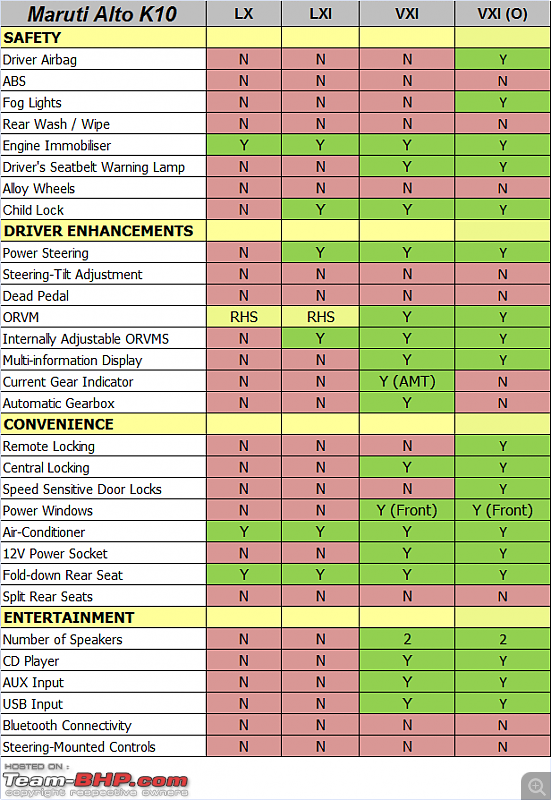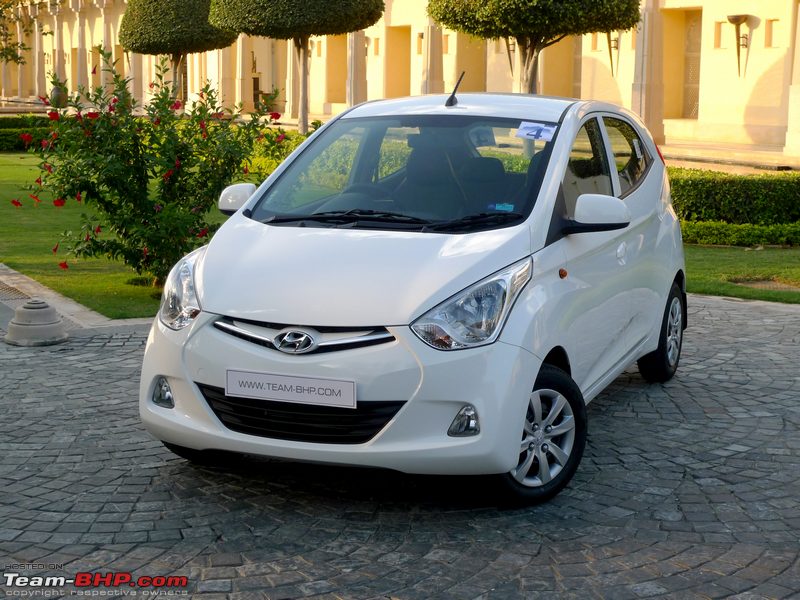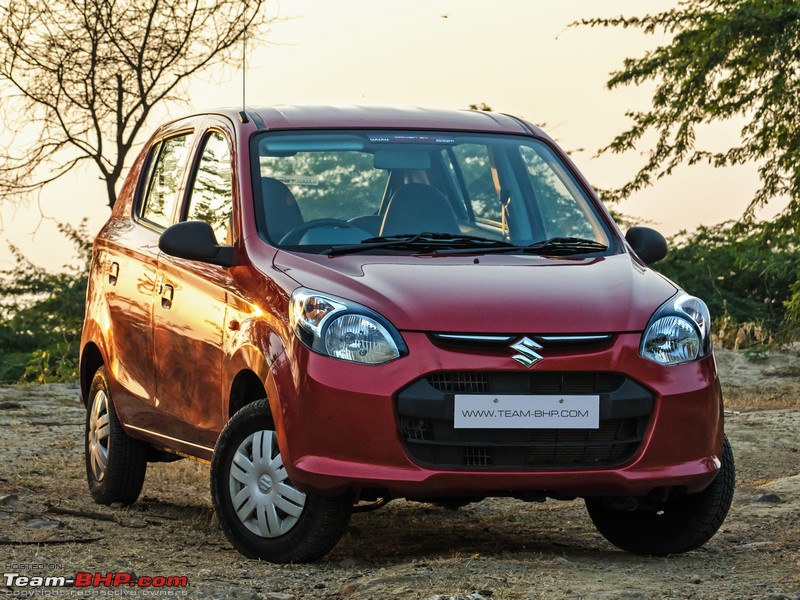| |||||||
 |
| Search this Thread |  630,096 views |
| | #1 |
| Senior - BHPian Join Date: Mar 2008 Location: Mumbai
Posts: 1,918
Thanked: 10,064 Times
| Maruti Alto K10 : Official Review The Maruti Alto K10 has been launched in India at a price of between Rs. 3.06 - 3.81 lakhs (ex-Delhi). What you'll like: • A much improved Alto K10 at the same price point • The cheapest automatic car available in India. VXI AMT starts at merely Rs. 3.80 lakhs • Power-to-weight ratio of 91 BHP/ton makes this one peppy li'l hatchback • More fuel-efficient than before. AMT variant is also an easy sipper @ 24.07 km/l • Compliant low speed ride quality. Soft suspension is absorbent • Convenient city car: Light, agile & easy to drive (especially the AMT variant) • Driver-side airbag & factory fitted CNG kit available • Maruti's excellent after-sales service & fuss free ownership experience What you won't: • Cramped rear bench. Also, the seatback is very short • Sensitive steering & nervous handling at speed. Best driven <100 kph • AMT lacks the refinement & shift-speed of conventional ATs • No ABS on any variant • Questionable structural strength. The car which it's based on (Alto 800) fared poorly in crash tests • Skinny 155 mm tyres beg for an upgrade • Flimsy build & economy grade quality. Poor NVH levels as well • More accomplished WagonR & Celerio are priced not too far away Last edited by GTO : 26th February 2017 at 10:15. |
| |  (23)
Thanks (23)
Thanks
 |
| The following 23 BHPians Thank S2!!! for this useful post: | .anshuman, AlphaLamb, amolbh, anilntny, AutoIndian, coolclouds, GTO, hemanth.anand, lrsays, manij, Nats, pulsar56, Rambo-RS, romeomidhun, S.MJet, samabhi, swiftnfurious, Technocrat, TheARUN, theexperthand, uday.ere, Viju, wishnipon |
| |
| | #2 |
| Senior - BHPian Join Date: Mar 2008 Location: Mumbai
Posts: 1,918
Thanked: 10,064 Times
| Maruti Alto K10 : Official Review  When India's largest car maker introduces an affordable & fuel efficient hatchback wearing the 'Alto' badge, things just don't get any bigger...or do they? If that car further offers the convenience of an automatic, it takes things to a different level. That is exactly what the new Alto K10 is. Developed in India & Japan at a cost of Rs. 200 crores (Alto 800 cost 470 crore), the highlight of this car is the optional Automated Manual Transmission (AMT). The Alto K10 is the cheapest automatic car available in India, at a price of Rs. 3.80 lakhs. If there is a company that can change mass market preferences, it is Maruti. Launching the Alto K10 AMT means taking this technology to the masses. We can safely predict that the Alto will be the best selling AMT-equipped car for a very long time. The only other AMT from the Maruti stable is the Celerio (priced between Rs. 4.14 - Rs. 4.43 lakhs). Sure, the Celerio was the first to feature an AMT, but being a new nameplate, it didn't enjoy the deep-rooted brand equity of the Alto - India's largest selling model since 2004. The Alto enters 21,000 homes each month (sales average for the last 6 months). It was in the year 2000 that Maruti launched the Alto as a more upmarket alternative to the Maruti 800 (then India's best selling model). The Alto was introduced in 2 variants - F8D (796cc) LX with 47 BHP and F10D (1061cc) VX with 63 BHP. Despite being more powerful, better equipped and priced merely Rs. 34,000 more than the 800 DLX, the Alto simply couldn't match the 800's volumes. Additionally, sales of the 1.1L VX were only a fraction of the 796cc LX, and it did cannibalise the Zen and Wagon-R to a certain degree. Finally in 2004, Maruti repositioned the Alto by discontinuing the 1.1L VX (exports continued though) and introducing a cheaper non-AC variant, thereby bringing the price gap down to Rs. 23,000. The Alto's factory supplies were prioritised over the 800 and the dealer push was more aggressive. It was only after these moves that the Alto managed to dethrone the 800 and become Maruti's new 'bread & butter' car. The 800 received such step-motherly treatment that it wasn't even upgraded to meet BSIV emission norms. Many years later, the successor to the F10D 1.1L Alto was launched as the Alto K10. In 2010, Maruti positioned the K10 variant as a more upmarket choice, compared to the Alto 800 which is the economy-grade model accounting for a majority of sales. It was powered by the 1.0 liter 3-cylinder K-series motor, shared with many other Maruti hatchbacks (including the best-selling WagonR). The Alto K10 fulfilled two important roles for the company - firstly, it sold alongside the regular Alto, hence widening the product's scope. Secondly, the Alto K10 bridged the gap between the entry-level Alto and the Zen Estilo / Wagon-R. It shared the underpinnings and body shell with the regular Alto. The only noticeable difference was the K10's front end which was 125 mm longer to accommodate the larger engine. In 2012, Maruti introduced a refreshed Alto 800 which cleverly capitalised on the Alto's as well as the 800's strong brand equity (review). The more expensive Alto K10, shockingly, continued with its decade old shape and outdated interiors. It's rather strange that the Alto 800 got the new body & stiffer chassis first. 4 years since launch & 4+ lakh sales later, the Alto K10 finally gets a much needed makeover. Being a car for the mass market, Maruti has adopted a conservative design approach. The styling is evolutionary, not revolutionary. The Alto K10's exterior design is neutral in nature, understandable as it has to appeal to several demographics. It won't make you go 'wow', but it won't offend you either. The key question is: does the new car look better than the old Alto K10? Definitely yes (although some BHPians miss the ol' classic). It's more contemporary for sure, even if the Eon looks that much snazzier & futuristic in comparison. The Alto K10 shares its underpinnings & body shell with the Alto 800. This results in the K10's dimensions being nearly identical to its cheaper sibling, save for the 150 mm additional length to accommodate the bigger engine. However, compared to the older K10, the 2014 car's length is 75 mm lesser, yet 15 mm wider and taller. The wheelbase, seat anchorage points, turning radius, ground clearance, fuel tank capacity, tyre size, suspension etc. remain the same as the older car. Give the new Alto K10 merely a casual glance and you'll instantly identify it as a product from the Maruti stable. It carries a distinct front identity with the wide swept back headlamps, single slat chrome grill wearing the 'S' logo and the large air-dam. There is a hint of resemblance to Hyundai's i10 Kappa2 here. I liked the subtle concave design on the bonnet. The side is identical to the Alto 800; Maruti has added blackened B-pillars, larger ORVMs, rubber side strips and 13" wheels (Alto 800 wears 12" rims). As mentioned earlier, the new model's nose is longer than the regular Alto 800 and this is evident from the side view. The rear can easily be mistaken for a Celerio or Alto 800. The Alto is built to strict costs and it feels that way too. The body panels and doors feel extremely light and flimsy. Paint finish is average, while overall fit & finish are standard Maruti fare. They're acceptable on a budget hatchback. The 2014 car is lighter than the outgoing model by up to 20 kilos, with a kerb weight ranging between 740 - 755 kgs (note: Hyundai Eon is in the same ballpark). This results in a power-to-weight ratio of 91 BHP/ton (equal to the VW Polo GT TSI)!! Even the AMT isn't heavier, weighing only 5 kilos more than the equivalent MT variant. This light kerb weight is also a contributor to its tall fuel economy. On the flip side, at high speeds, crosswinds or heavy vehicles passing by can unsettle the Alto K10. If the performance of the Alto 800 in the Global NCAP crash test is anything to go by, we can conclude that the Alto K10 isn't going to fare any better. This car is primarily suited to the city and should be driven at moderate speeds only. Even the glass used is so thin that, with the windows rolled up, we actually overheard a conversation between a biker and pillion (who were waiting beside us at a traffic light). In the Alto VXI (O) trim, the equipment list includes air-conditioning, front power windows, internally adjustable ORVMs, power steering, central locking, speed sensitive door locks (locking all 4 doors at 25 km/h), driver-side airbag, front fog lamps, remote-key entry and an integrated audio system. Interestingly, in the year 2000, its predecessor (the Alto VX 1.1L F10D) came with a leather wrapped steering wheel, rear wash & wipe and 'lights on' reminder which are all missing from the new car. Maruti gives the Alto driver an option to choose between safety for his head and freedom for his left leg  . That is, the AMT isn't available in the top VXI (O) trim level. I'm sure a lot of safety conscious buyers would have liked the convenience of an automatic and wouldn't mind paying extra for a VXI (O) variant with the driver-side airbag, foglamps, remote key entry & speed-sensitive door locks. On a related note, we wish Maruti had ABS on the options list too. ABS is as important as an airbag, if not more. . That is, the AMT isn't available in the top VXI (O) trim level. I'm sure a lot of safety conscious buyers would have liked the convenience of an automatic and wouldn't mind paying extra for a VXI (O) variant with the driver-side airbag, foglamps, remote key entry & speed-sensitive door locks. On a related note, we wish Maruti had ABS on the options list too. ABS is as important as an airbag, if not more. Product overlap is inevitable between the Alto 800 and K10. Someone opting for the Alto 800 VXI (Rs. 3.11 lakhs) might easily sway in favour of the K10 LXI (Rs. 3.21 lakhs). The Alto 800 would score due to the option of airbags on the LXI (Rs. 3.13 lakhs) & VXI (Rs. 3.28 lakhs). For others, the K10's motor and modern-looking interiors would be the pick over the plain jane Alto 800. Look a little higher and you'll catch the Celerio, starting at Rs. 3.76 lakhs (base MT) and Rs. 4.14 lakhs (base AMT). The difference of Rs. 28,000 over the Alto K10 AMT is nothing in EMI terms. The Celerio is a far superior car in nearly every way, be it modernity, space, on-road behaviour etc. On its part, Maruti couldn't care less about product cannibalisation as long as the customer stays in their showroom. A more mature makeover:  It gets a distinct face that somewhat resembles the Hyundai i10 Kappa2 when viewed head on: 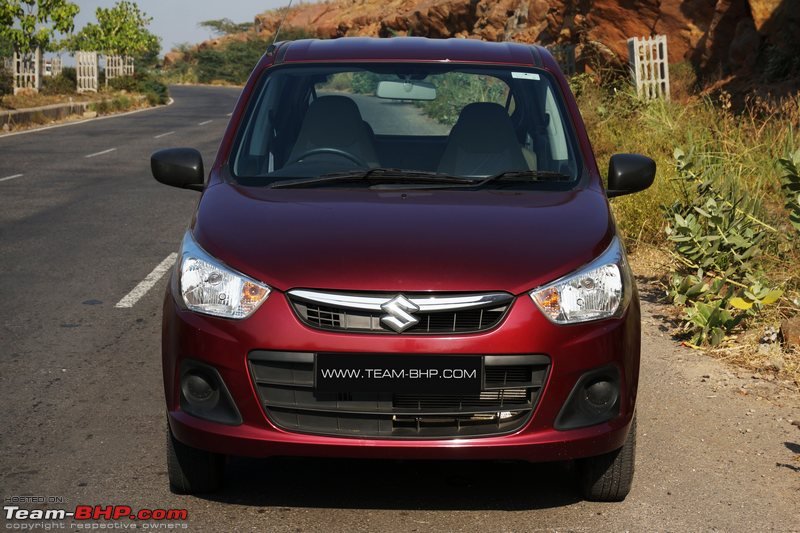 A casual glance at the rear and you'd easily pass it for an Alto 800 or Celerio. Only after a closer look will you realise that the K10's tailgate is the most subtle. The other 2 have distinct character lines: 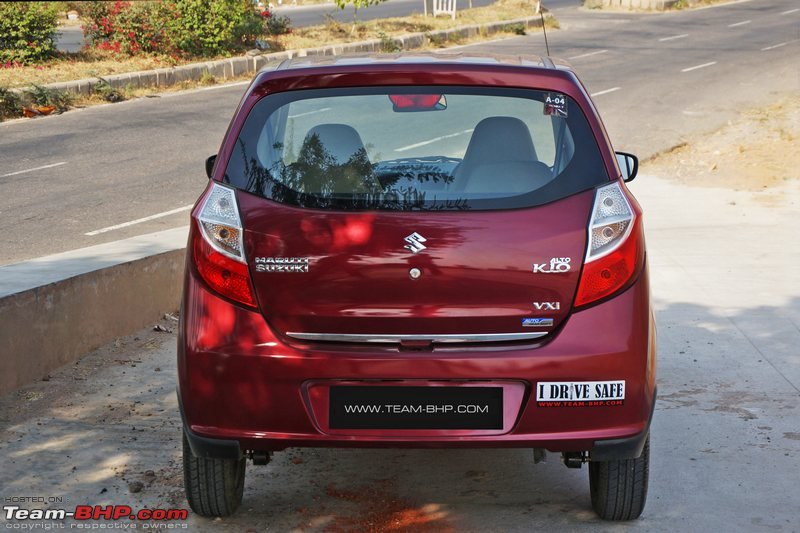 The roof slopes downward towards the rear and the rear window area is much smaller than the outgoing car. The shoulder line finds its way on the K10 too. Body side moulding, blackened B-pillars, larger ORVMs and 13" wheels differentiate it from the Alto 800. I think the side moulding is placed too high:  I loved the concave-ish bonnet design. Notice the (left) headlight bulge in the picture. Another interesting facet to be observed is when you look at the front grill & air dam closely - one side is open, the other is covered: 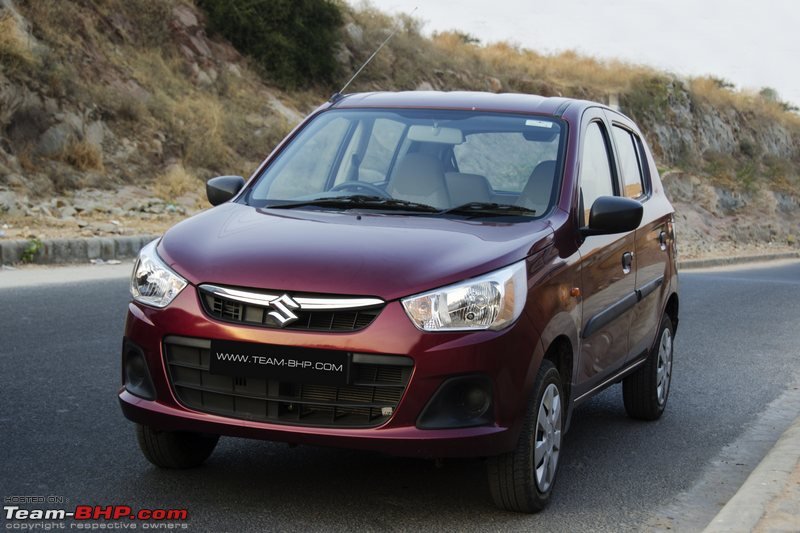 The 2014 Alto K10 is 15 mm taller than its predecessor and it shows. Ground clearance is unchanged at 160 mm. Stance of the older car looks sportier in comparison to its taller successor: 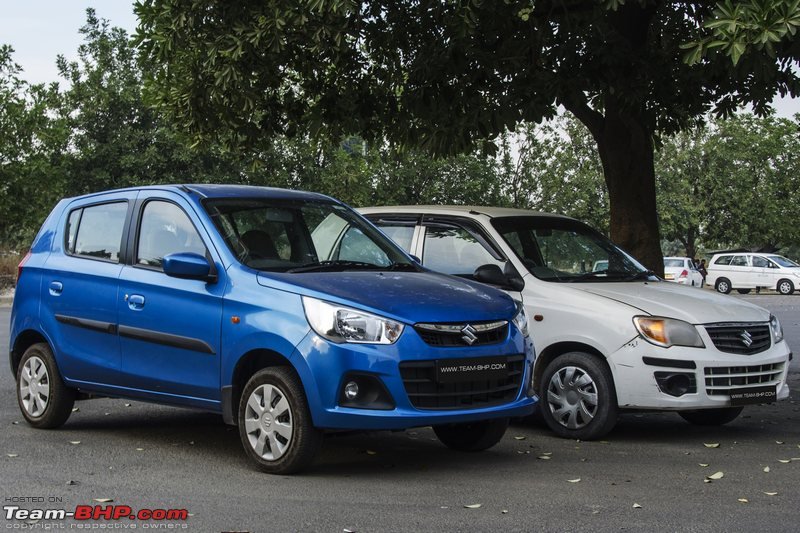 Undeniably, the 2014 car looks a lot more contemporary when parked next to its predecessor. Trivia: the 'Alto' badge was larger than 'K10' on the ol' car; it's the other way around now. 4.3 lakh units later, the K10 has created an identity of its own: 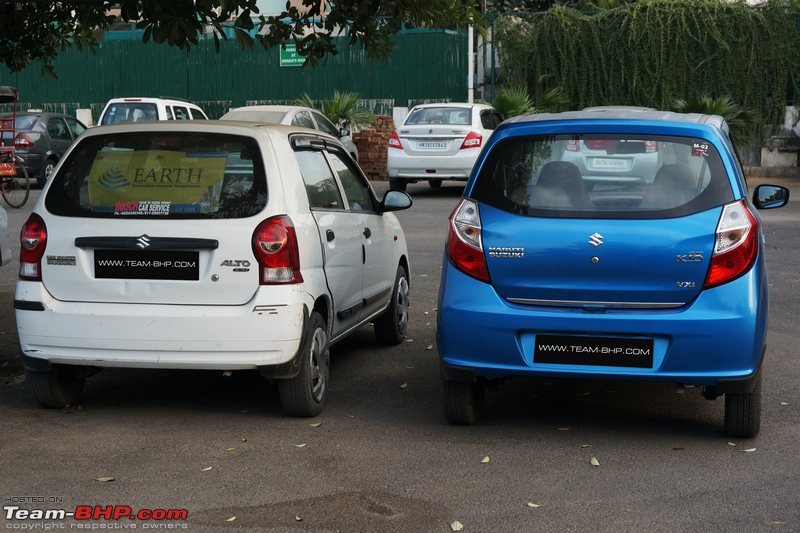 Swept-back headlamps:  A single slat chrome grill with the big 'S' logo. Left side of both grilles are closed:  Number plates move up with the all-black air-dam (older Alto alternated between black & body coloured slats):  Trapezoidal foglamp housing. The VXI doesn't get foglamps; VXI (O) does:  Single washer with budget quality wipers:  Like the outgoing car, the 2014 K10's nose is longer than the Alto 800's by 150 mm to accommodate the bigger engine. Also, the paint on the bumper has a matte effect (vis a vis glossy finish on the body panels):  Ribbed roof adds some rigidity to the otherwise light body shell:  Skinny 155/65 R13 JK Tornados can't handle the power-to-weight ratio of this car. The LX and LXI variants don't get full wheel covers:  I'm glad to see ORVMs from the Celerio, rather than the puny ones of the Alto 800. VXI (O) gets body colour here:  B-pillars are blackened by a vinyl. It should have joined the topmost point of the windows, but that isn't the case:  Outdated 'flap-type' door handles. VXI (O) gets them in body colour:  Body side moulding is standard on the VXI (O) only. Can be fitted as an optional extra:  Completely unclad wheel wells! Poor insulation allows road noise into the cabin:  While their overall design is similar to the Alto 800 & Celerio, the tail-lamps manage to have a distinct identity of their own. Notice the body shoulder line continuing through them:  We'll be seeing a lot of these on the streets soon. An AT for the masses, who would've thought?!  Optional chrome strip fitted on our test vehicle looks nice and adds a premium touch:  Stick your eye to the body and you'll realise that paint quality is strictly average: 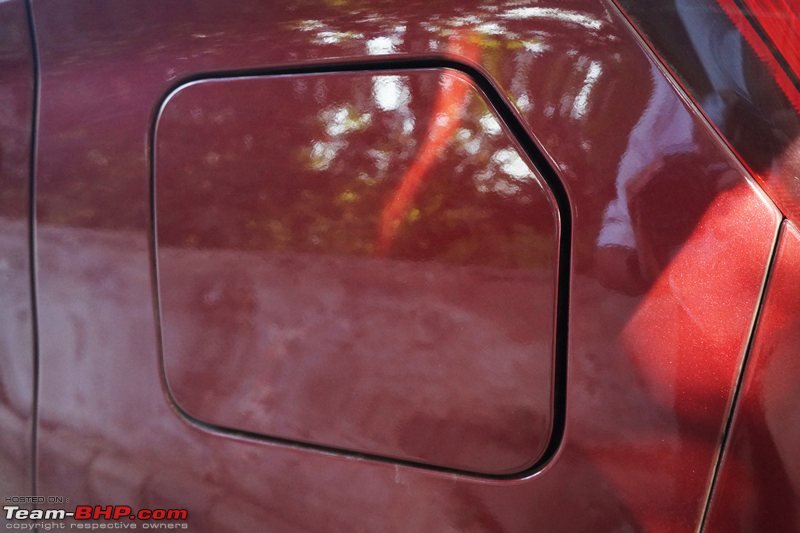 Last edited by GTO : 30th December 2014 at 15:03. |
| |  (15)
Thanks (15)
Thanks
 |
| The following 15 BHPians Thank S2!!! for this useful post: | abhinavinc, ani_meher, AutoIndian, Chethan B G, GTO, manij, romeomidhun, S.MJet, shobhit.shri, swiftnfurious, Technocrat, theexperthand, uday.ere, V.Narayan, wishnipon |
| | #3 |
| Senior - BHPian Join Date: Mar 2008 Location: Mumbai
Posts: 1,918
Thanked: 10,064 Times
| Maruti Alto K10 : Official Review Interior - Front  The Alto K10 is a low slung car and ingress / egress aren't as convenient as in the tallboy hatchbacks. Once inside the cabin, you'll immediately appreciate the design. Aesthetically, the beige & black colour theme gives the interiors a nice feel. It's a big step ahead of the older Alto K10. Maruti's designers have tried their best to make you feel like you're in a 2014 car, and not a low cost hatchback. Sure, the quality of material is very economy grade, and the plastics are ordinary, yet fit & finish are acceptable for the 3 lakh price tag. From purely a design perspective, I prefer the Alto's simpler interiors to the Hyundai Eon's. No contest on the quality front though, the Hyundai is f-a-r superior there. The dashboard has a fair share of cuts & creases to add some definition. In fact, the crease around the center console makes it appear tilted towards the driver (similar to the Elite i20). However, this isn't actually the case; it's just a design trick (the center console is flat). The piano black audio system console looks like it is from a more expensive car. You might have guessed already - yes, it is a fingerprint magnet. There are matte silver buttons & accents around the side vents, on the door handle and door armrest...these look neat too. The lower half of the dashboard is beige, but the designers have made sure that all the contact areas are black. Even the air-con controls (except the A/C switch) are black, unlike the beige ones found in the Dzire & Ertiga. The front seats are rather thin and offer basic levels of support. They wear a pleasant two-tone beige colour which helps in making the cabin feel bright and airy. Having said that, the seat upholstery is prone to getting soiled easily. The seats have a healthy travel range too. With the seat pushed all the way behind, as a front passenger (at 5'10"), I could literally stretch my legs. Not possible with an adult on the back seat though. The integrated headrests of the front seats are placed too far behind. Even as a passenger, I had to bend my neck backwards uncomfortably to rest my head on it. Another irritant I found was how the seats are placed so close to the doors. If you wish to adjust the backrest, you have to squeeze your hand through the small gap to reach the tiny lever. As a driver, you have excellent all-round visibility. The A-pillars are slim, glass area generous and taller drivers will enjoy peeking at the bonnet while driving. The ORVMs are fairly wide, although I felt that they should have been a little taller. Rearward visibility is satisfactory (helped by the low seatback of the rear bench) and the IRVM does the job too. The steering wheel is small and lacks thumb contours, albeit it does have finger grips (like older cars). The horn pad is easy to reach and drivers with smaller hands won't have to stretch their thumbs to honk. The steering is in a fixed position and doesn't have tilt adjustment (the Hyundai Eon does). Overall ergonomics are satisfactory and most controls are placed right where you'd expect them to be. The A-B-C pedals are comfortable and the gear shifter falls right into your hand. While fit & healthy folk shouldn't face any issues, someone with a heavy build won't be too comfortable driving the Alto K10 over long journeys. The B-pillar eats into shoulder space, the seats offer limited lateral support and there's no under-thigh support for tall drivers. In fact, being a low car, 6-footers sit in a knees-up position. When you are sitting in that position, your thighs might lean against the door armrest. This is when you'll realise how thin the doorpads actually are - operate the power windows and you literally feel the window mechanism flexing the doorpads. Speaking of power windows, the switches have an unergonomic location below the gear console. The older Alto K10's window switches had an aftermarket'ish location on the doors, yet they were more logically placed. Moderator Anshuman also commented that the handbrake is placed too low. This is all the more noticeable in the AMT variant where the handbrake is used more often (as compared to the manual tranny). Another unpleasant surprise is that the doorpads don't get any fabric inserts, whereas those of the Alto 800 do! The air-conditioner did a competent job of keeping us cool throughout the drive. We never felt the need to set the blower speed above level '2' at any time. The side air-con vents can be shut completely when you so wish (~5% of air filters through anyway). The middle vents can't be adjusted for volume though. On a related note, it's ridiculous how Maruti calls this unit a "dial-type climate control" in the brochure. The integrated audio system is finished in piano black with matte silver buttons. I personally liked the OEM design. Anshuman, however, says he would have preferred a single din piece like the older car. The Alto's music system supports CD, Aux, USB and radio. Sound quality from the front 2 speakers is typical OEM stuff. It's worth a mention that the bass levels are quite pleasing. Every time you tune into the radio, remember to pull out the manual antenna for better reception, just like in the 90's. Also be sure to push it back in when you park the car, as these are susceptible to damage. The dashboard has an incredibly nifty bag hook with a load rating of 2 kgs, on which you can hang your grocery stuff or takeaway food parcels. The top of the dashboard has a recessed area where you could stick an idol or place 'em anti-slip mats for loose items. There is a small storage area beside the central air vents to park toll-tickets and coins. The doors have thin pockets, but no bottle holders. The glovebox is of a medium size. It's placed too low though. To access the glovebox, the front passenger will have to spread his legs inappropriately, else his knees will prevent it from opening. The Alto MT is equipped with 2 cupholders and a deep cubby hole ahead of the gear console. If you place your phone here, you'll have to stretch your arm to pick it up as the cubby hole is very deep. The AMT console is different; it cuts down the storage space and leaves you with a smaller & shallower cubby hole. No, you don't get cupholders in the AMT. Since there is no passenger airbag on offer, the area above the glovebox could've been utilised for a storage shelf (like in the Alto 800). 3-spoke steering with silver accents looks nice. It lacks thumb contours. Those with shorter hands won't have to stretch their thumbs too much to honk. The Eon's steering has tilt adjustment...K10 doesn't: 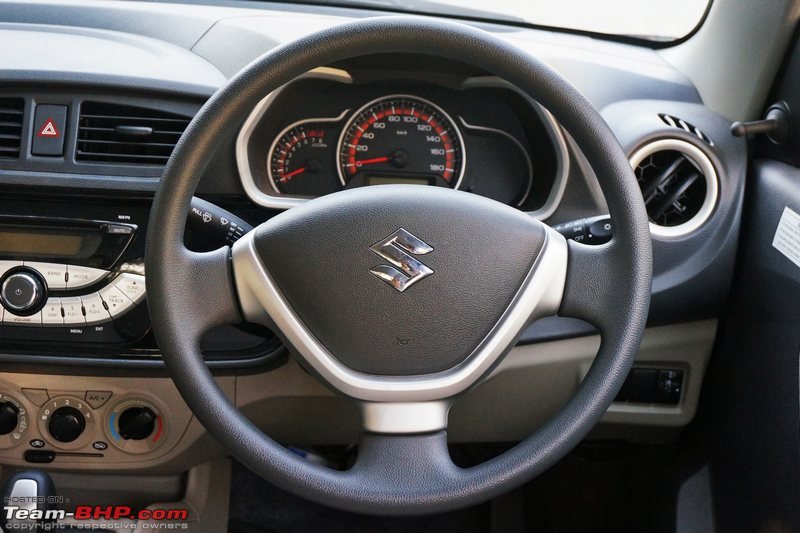 Easy to read speedometer. No temperature gauge; instead, you get a warning light if the engine overheats:  Only car in its segment that comes with a tachometer! It's marked till 8,000 rpm. Notice the driver's seatbelt reminder sign (no audible beep though):  Different MID than the Alto 800. It consists of an odometer, 2 trip meters, digital clock and digital fuel gauge:  Stalks are easy to reach and feel durable:  Alto 800 comes with fabric doorpads, Alto K10 doesn't! An oversight by Maruti? Door pockets are too thin:  Matte silver accents on the door handle and armrest bring some life to the otherwise boring design:  Pull/push type door locks: 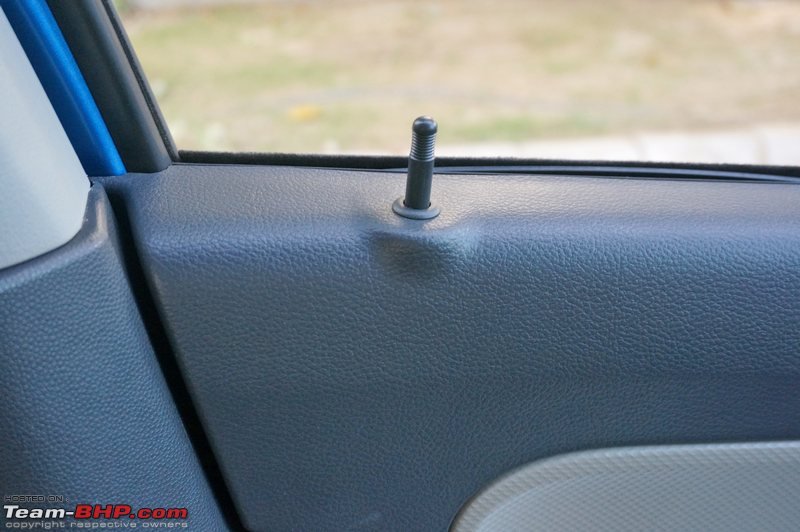 Thin front seats with integrated neck restraints. Two tone beige fabric upholstery brightens up the cabin, but can get soiled easily. Lower variants come with a different fabric design:  Notice the tiny backrest adjustment lever:  Fuel lid and tailgate opener. Central locking acts on the 4 doors only, and not the boot. We like it this way:  Pedals are adequately spaced out. Clutch operation is light, it's a breeze to use in the city:  Side air-con vents look similar to those on more expensive Marutis. Can be shut (5% of air comes through anyway):  Recessed area above the dashboard. We don't suggest placing your smartphone here as it can easily slip...and even get stolen!  The center air vents are different. Notice this deceiving dashboard crease which makes the central fascia appear tilted towards the driver...  ...in reality, the central fascia is flat. I like the piano black audio system with the matte silver buttons. Even the chrome ring around the power/volume knob looks nice:  A little cubby hole to store toll tickets or coins:  Nifty bag hook on the dashboard, with a load rating of 2 kilos. To hang grocery bags or takeaway food parcels:  A 2 speaker audio system that supports CD, MP3, USB & Aux inputs: 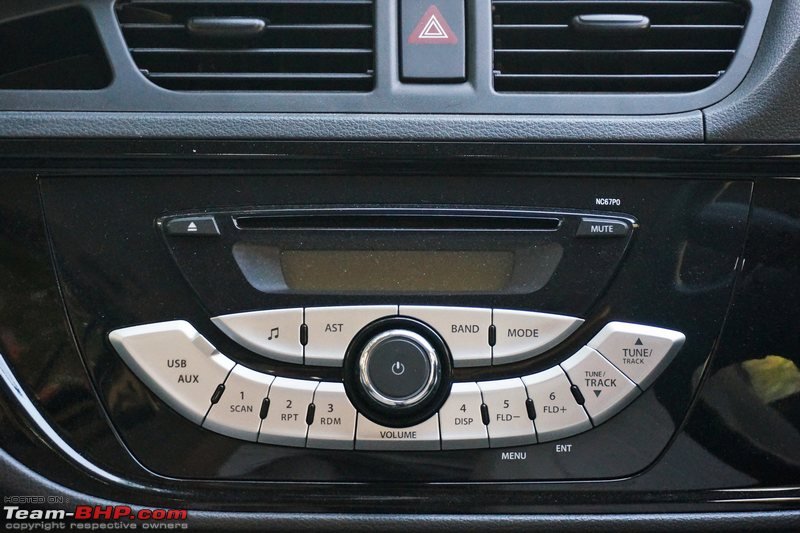 Cleverly hidden USB & Aux-in slots. Looks like a button when closed. We're not sure whether this cover will take abuse over the years:  Unlike the beige units of the Dzire & Ertiga, air-con controls are black in here. They won't get stained easily. Air-conditioner is very effective:  Deep cubby area to store the knick-knacks. Notice the user-friendly 12v socket location. The manual car also gets 2 cupholders:  5-speed manual gearbox isn't the slickest one around, yet the gates are well-defined and it is a sure-slotting unit:  Unergonomic location for the power window switches. The older car had it on the doors - a more logical place:  For taller drivers, the handbrake lever is a stretch (i.e. it's too low). You'll realise this more in the AMT car, where it will be used more often:  Medium size glovebox:  Front passenger's knees will deny access to the low-positioned glovebox:  ORVMs are larger than the Alto 800's:  Stalks for internally adjusting the ORVMs don't feel flimsy:  IRVM is functional and does the job. No day/night feature though:  Rear windscreen size is acceptable, although the C-pillars can hamper visibility while parking:  El-cheapo sun visors! Passenger gets a vanity mirror:  Last edited by GTO : 4th December 2014 at 11:50. |
| |  (13)
Thanks (13)
Thanks
 |
| The following 13 BHPians Thank S2!!! for this useful post: | abhinavinc, Chethan B G, GTO, manij, NetfreakBombay, romeomidhun, S.MJet, Shridhar, sumeethaldankar, Technocrat, theexperthand, uday.ere, wishnipon |
| | #4 |
| Senior - BHPian Join Date: Mar 2008 Location: Mumbai
Posts: 1,918
Thanked: 10,064 Times
| Maruti Alto K10 : Official Review Interior - Rear  Just like the Alto 800, ingress & egress will require some skill. Why? It's because the gap between the B-pillars & rear seat is too less. You first have to twist your feet to step in and then, mind your head from bumping into the low roof line. It's the same procedure when getting out. In comparison, stepping in and out of the Tata Nano is a breeze. Maruti engineers have cleverly scooped the seatback of the front seat to liberate a little more knee space. Legroom is what you'd expect from a small entry-level hatchback. It's limited, and the rear seat is best for those of an average height. 2 tall passengers sitting front & back will make things very cramped. Must be added that, if a passenger buries his knees into the front seatback, the driver can feel it! The Tata Nano & Datsun Go offer significantly more space & comfort. The basic rear bench is narrow and two healthy occupants will occupy ~75% of the seat. Essentially, the Alto is a four-seater car. The seat is on the smaller side, yet offers surprisingly decent under-thigh support. On the flip side, the seatback runs too short and doesn't support your entire back. The integrated neck restraints are low as well, and can only be used by smaller passengers or kids. You tend to sit higher than the front seats and get a good view of the journey ahead. The ambience is light due to the interior colours (you won't feel claustrophobic). That said, the rear windows are much smaller than those of the ol' Alto K10 and there's lesser sunlight coming in. Rear occupants get a single storage area = the nifty, foldable bottle holder (behind the handbrake console) which can swallow a 1L bottle. Nothing other than this...no door pockets, cubby holes or seatback pockets. Any other loose items will have to be placed in your trouser pockets or on the rear parcel tray that is recessed to prevent objects from sliding forward. The boot has a capacity of 177 liters (same as the Alto 800). Its carrying ability is par for the segment. The rear seat can fold down when you need additional luggage space. Small gap between the seat and B-pillar results in tricky ingress/egress:  Even the VXI (O) doesn't get rear power windows. Simple doorpad, no storage pockets. Rear armrests are wider & more usable than the Alto 800's:  Rear window rolls down ~95% of the way:  Rear bench is small. 2 healthy adults will occupy a significant area of the seat:  A closer look at the seat fabric:  This isn't a spacious hatchback. At 5'10", I snugly fit onto the rear bench. Notice how pointless the neck restraints are for guys like me. If you want a good back seat, look at cars like the Datsun Go instead:  Scooped front seatbacks help release some more knee room:  Maximum & minimum legroom:  Headroom isn't an issue. Observe how the roof liner isn't flat; you can see the support beams:  Floor hump isn't intrusive, but a 5th occupant isn't welcome anyway. The tiny cabin doesn't have enough width for him:  Useful 1L bottle holder which can be folded away when not in use:  Rear parcel tray is flat & recessed. It won't let loose items slide off...at least not easily:  Loading bay is narrow while the loading lip is on the higher side: 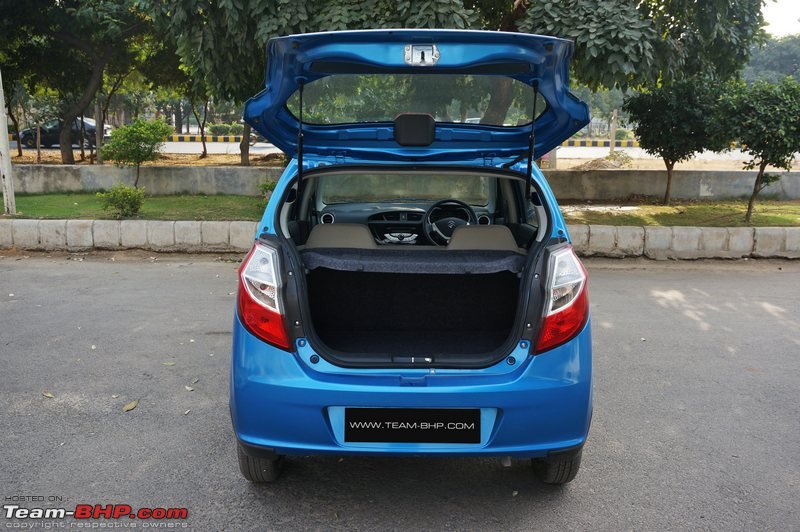 Double gas struts to open the boot. No cavity or handle to help with pulling down the hatch: 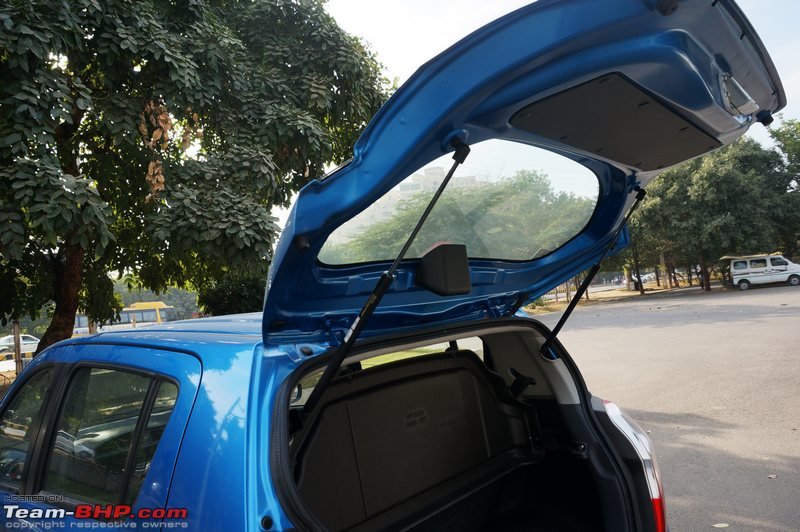 177 liter boot is identical to the Alto 800. It can be stuffed with a couple of cabin bags at best. The hole on the boot floor is to access the spare wheel:  Yep, the rear seat does fold down. It doesn't fold entirely flat though. No 60:40 split either:  The rear seatbelt holder / clip:  Full-size spare wheel. Take that, German luxury car makers! 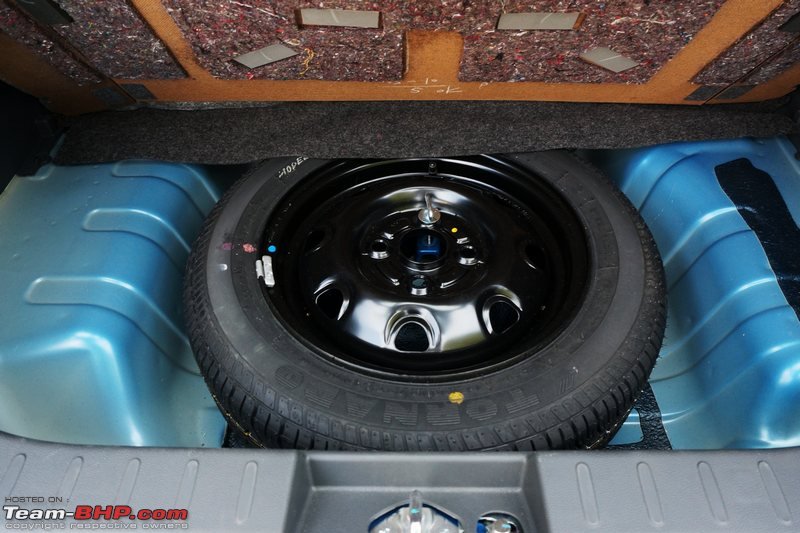 Last edited by GTO : 4th December 2014 at 11:41. |
| |  (18)
Thanks (18)
Thanks
 |
| The following 18 BHPians Thank S2!!! for this useful post: | Chethan B G, driverace, GipsyDanger, GTO, InControl, manij, phynix123, psankar, Reinhard, romeomidhun, saket77, swiftnfurious, Technocrat, The Great, theexperthand, uday.ere, V.Narayan, wishnipon |
| | #5 |
| Senior - BHPian Join Date: Mar 2008 Location: Mumbai
Posts: 1,918
Thanked: 10,064 Times
| Maruti Alto K10 : Official Review The AMT - Automated Manual Transmission  The talking point of the Maruti Alto K10 is undoubtedly the Automated Manual Transmission (AMT) - so let's talk about that before getting to the engine. How it works is pretty straightforward. Mechanically, the AMT gearbox is identical to the K10's 5-speed manual transmission. What's different is how the clutch is operated and how the gears are shifted. In the manual, the driver is responsible for these tasks. With the AMT, hydraulic actuators (located in the engine bay) operate the clutch and shift gears. There's no clutch pedal, and zero driver input is required for gearshifts, making it exactly like a conventional automatic to drive. Simply put, the mechanical functions of operating the clutch and gear lever have moved from inside the cabin to the engine bay. Starting the engine up must be done with the gear lever in Neutral. You have to press the brake pedal as well, else the engine won't start. There's no 'P' (park) mode or gear unlock button like in a conventional AT. Once fired up, slide the gear lever to 'D' (drive) to get going. As you release the brake, the car will move forward without any accelerator input. However, it doesn't move too fast and will top out at about 6-7 km/h, without any driver input. When you press the accelerator, you'll notice that throttle response is quite immediate. It's exactly like a pure manual in this respect. In city traffic is where the AMT truly shines and brings the most benefits. There's no clutch pedal and there's no requirement for the driver to repeatedly shift between Neutral-1st-2nd either. In crawling bumper to bumper traffic, you don't need to give any accelerator input. Just release the brake a little bit, and the car crawls forward. Start-off is extremely smooth. At these speeds, there is no difference felt between the AMT and a conventional AT. In fact, this is more like a DSG in stop & go traffic since the mechanism is identical (but only between Neutral and 1st gear). Maruti used the term 'EZ Drive' to market the AMT at the Celerio's launch; we couldn't agree anymore. Budget car owners will love the fact that their left leg is completely relaxed. The tricky part with the AMT in city driving though is parking into tight spots. Unlike a conventional AT where it's possible to ease the car forward very gradually, the AMT is more of an 'on or off' solution, as it tries its best not to slip the clutch more than required. This results in more eager movement, which can be a bit tricky when getting in & out of tight parking spaces. Gearshift quality is a universal sore point for Automated Manual Transmissions. The Alto's AMT is no different. Despite the start-off from standstill being seamless, it's the following gearshifts that are indeed noticeable. First-time automatic drivers won't have any complaints with the AMT. However, those used to smoother AT gearboxes will definitely notice the compromise. The first time you drive off, you'll be accelerating and then, there is suddenly a lull in acceleration when the car shifts up to 2nd gear. You can certainly feel this drop in momentum, as the clutch disengages and engages, especially from the driver's seat. On your first few drives of the AMT, this upshifting and the resultant loss in acceleration can get annoying!! Another example: If you're cruising along at 40 km/h in 4th gear, and you press the accelerator to get a little more power, you'll feel a lull before the acceleration actually kicks in - because the gearbox is shifting down to 3rd gear. On each gearshift, you feel your body move forward due to the mismatch of anticipation and reality. The lag in power during gearshifts is more noticeable during uphill climbs, since the drop in acceleration is more pronounced. Sounds like a disappointment? Fret not. There's a silver lining on this cloud. Firstly, no matter how evident the gearshifts seem to the driver, passengers won't notice them. Passengers just don't anticipate shifts the same way the driver does, and this makes it a smooth ride for them. Secondly, there are some simple driving tips you can apply to make your gearshift experience smoother. If you drive with an extremely light foot, the shifts will be much less perceptible, since the drop in acceleration at each shift won't be as large. Another tip that some might get used to, others will find cumbersome: When accelerating up to speed, let off the accelerator at intervals, and the AMT will cease that opportunity to upshift. E.g. When going from 0-40 km/h, let off the accelerator very slightly at 10, 20 and 30 km/h, and the AMT will take each one of those opportunities to upshift a gear - almost like you told it to! Finally, you'll be happy to know that shift quality gets better between higher gears, and is virtually seamless when going downhill. It's also completely silent in its operation. There's absolutely no noise or clunking when the gears shift. Fuel efficiency is without a doubt what the AMT has been tuned for. This means the transmission is very eager to upshift and before you know it, you will be cruising along in 5th gear at speeds of 50 kmph. Even in crawling traffic, the AMT will upshift to 2nd gear at a fairly low 10-12 km/h. With a light foot, upshifts take place at roughly every 10 km/h. Translated, 30 km/h for 3rd, 40 km/h for 4th and so on. At 40 km/h, the car was already in 4th @ 1200-1400 rpm. The minute that rpm levels drop to 1100 or below, the transmission will downshift to a lower gear. The 'current gear indicator' on the MID keeps you in the loop as to which gear is engaged. It's quite a novelty and will be appreciated by prospective and existing owners of the Alto K10 AMT. It adds to that premiumness, as even some of the more expensive cars don't have this feature. The engine gives out a nice blip on kick-down, and doesn't hesitate to drop two or three ratios at a time (e.g. 5th to 2nd). With a heavy foot on the accelerator, the AMT holds a gear all the way till the redline before upshifting. The driver also has an option of 'manual mode' to prevent premature upshifts while overtaking on highways. When used right on the highway, the AMT is better than some lazy CVTs in the market (the Nissan Micra's CVT, for example). Manual Mode has other advantages, especially for the more enthusiastic drivers who want a higher degree of control. Other than the Celerio, Grand i10 and the pricey Polo TSI, this is the only other hatchback to offer a tiptronic-like manual mode. Towards the right of the MID gear indicator, there is a small alphabet readout: 'M' for Manual & 'D' for Drive, indicating the mode that you are currently in. In manual mode, you can redline all day and the AMT will still not upshift automatically. Conversely, if the rpm drops too low, the AMT will downshift to prevent the motor from stalling. If you try to upshift at too low an rpm or downshift at too high an rpm, the AMT will ignore your instructions and flash the gear indicator in protest. It's always a good idea to switch to manual mode before your favourite ghat section, because it prevents sudden & unsettling gear changes mid-corner. 0-100 times are also best tried in manual mode, but they certainly won't match up to the true manual Alto K10. Why? For a hard launch, the AMT takes almost an entire second to realise the urgency and even after that, it won't charge ahead, but instead move leisurely. The Alto MT is quicker as you can build the revvs and dump the clutch at launch. Even upshifts aren't as quick as what a good driver can pull off (leave aside the lightning-quick DSG's shifts). An advantage of manual mode is that you can increase the amount of engine braking when going downhill. It's quite effective, although not as aggressive as in a pure MT. A good thing is that the AMT doesn't ever free-wheel (some dual-clutch ATs do). It always keeps the clutch & gearbox engaged, resulting in better control. We recommend shifting to manual mode before overtaking, when you need engine braking and of course, the times that you are in the mood for some fun. Hill starts require that you use the correct procedure in order to minimize rollback. There's even a sticker on the driver's door advising you to use the handbrake to aid starting on an incline. When starting off on a hill, switching your foot immediately from the brake to accelerator will result in the car rolling back....before it engages the clutch and moves forward. On a steep hill, the car can roll back as much as 3 feet before moving forward. It's dangerous, and also bad for the clutch in terms of wear & tear and overheating. In fact, there's a special 'transaxle overheating' warning light just for this. Thus, it's best to use the parking brake when starting off on an incline. This results in only an inch or two of rollback and a very gradual start-off. A 'Hill Hold' braking function would have been a neat addition, but we can't complain too much considering its affordable price tag. I'd also like to add that the AMT manages the clutch & gearbox a lot better than sub-par drivers out there. There's no doubt that it is more talented than a below-average driver in choosing when to shift, how to shift and what gear to drive in. Understanding the AMT better: • The Alto K10's light kerb weight of 755 kgs makes it feel peppier than the Celerio AMT. Further, its smaller dimensions & good all-round visibility make this the easiest car to drive in the city. • Maruti has definitely fine-tuned the AMT post the Celerio's launch, and their learnings from the same. Anshuman (who has driven the Celerio AMT) felt that the shifts were smoother in the K10. Also, 80% of the time, the AMT was in the correct gear and it didn't seem to be hunting for the right gear as much. • If you're in Drive and pull up the handbrake (say, at a traffic light), the clutch will automatically disengage. This is far more convenient than shifting to Neutral each time you stop. To start moving again, you need to lower the handbrake and press the accelerator. If you don't press the accelerator, the clutch will remain disengaged and the car could roll forwards or backwards (depending on the slope of the road). • Further to the point above, for regular usage, there is no need to use Neutral, other than for starting the car. Even when you're stationary in 'D', just engage the handbrake and it's as good as Neutral. Do remember to completely press the brake pedal to start the car; partially pressing it won't help. • Ask the gearbox to do anything that it doesn’t want to do, and you'll see the gear indicator blinking. Downshifting at too high an RPM? It will blink. Upshifting at too low an RPM? It will blink. • If you're not in Neutral with the brake pedal pressed, the engine won't start. Instead, the car will blink the gear indicator and beep constantly. • If you're in Neutral and shift to Drive/Reverse without pressing the brake, the system beeps and the car remains in Neutral. The 'N' sign flashes and the brake icon shows up. You have to switch back to Neutral, press the brake pedal and then select Drive/Reverse. This can get super-annoying while parking because the gear lever moves and you feel that you have shifted, but in reality, it remains in Neutral till you press the brake while shifting. • There is an audible clunk from the engine bay when you switch between Drive, Reverse & Neutral (but not when it shifts up or down gears on the move). • If you're lugging uphill (not pressing the accelerator) in 1st gear and the incline or load gets too much for the car, it won't stall like a manual transmission would. Instead, the AMT will just disengage the clutch and you start rolling backwards  • Not sure how the AMT will behave once the clutch starts to wear out. Will AMT clutches have to be replaced sooner than MT clutches? Proper clutch service and setting will play an important role with the AMT's performance. And remember, use the handbrake on inclines! • Turning off the vehicle with the transmission in Neutral leaves you entirely reliant on the handbrake, when parked on an incline. We suggest you turn your Alto K10 off in either "D" or "R" instead, which will provide a secondary brake force (just like parking a manual car in 1st or Reverse). This Magneti Marelli box has the hydraulics that operate the clutch & gearshift (instead of your limbs):  AMT has only 3 modes - R, N and D (i.e. Reverse, Neutral & Drive). It does offer 'Manual mode' (slide gear lever to the left)....something many expensive cars don't:  AMT's gear console area is different. The cubby area in front of the gear lever is shallower, while the 12v socket moves above the power window switches. No cup-holders like the MT variant. Weird? You bet. Will your left hand be free for a coffee cup in the MT or AMT?  A different MID for the AMT. Gets a current gear indicator on the left, with the digital fuel gauge on the right:  The "D" (above the odometer) changes to an "M" when you're in Manual mode:  No dead pedal here, yet there's sufficient space to rest your left foot:  Like the Celerio, the Alto's doorpad wears a sticker with some AMT tips: 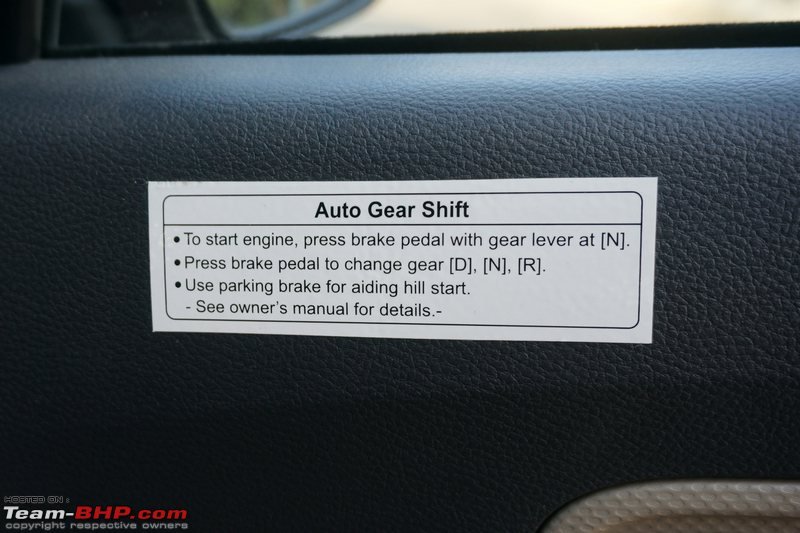 Last edited by GTO : 5th December 2014 at 10:54. |
| |  (16)
Thanks (16)
Thanks
 |
| The following 16 BHPians Thank S2!!! for this useful post: | GTO, humbleroadster, jassi_jeeper, manij, Rajeevraj, Rambo-RS, Reinhard, romeomidhun, S.MJet, swiftnfurious, Technocrat, The Great, theexperthand, V.Narayan, Viju, wishnipon |
| | #6 |
| Senior - BHPian Join Date: Mar 2008 Location: Mumbai
Posts: 1,918
Thanked: 10,064 Times
| Maruti Alto K10 : Official Review  The Alto K10 is powered by the familiar 3-cylinder, 998cc K-Next motor churning out 67 BHP @ 6,000 rpm (vs 6,200 rpm in the older car) and 90 Nm of torque @ 3,500 rpm. This is essentially a reworked K10B unit which also powered the older Alto K10, but now comes with a higher compression ratio, low viscosity engine oil as well as drive-by-wire tech (electronic throttle). The retuning & lighter kerb weight result in the motor being more fuel efficient than before, extracting 24.07 km/l in the manual and AMT variants (vs 20.2 km/l in the older K10 and 22.74 km/l in the Alto 800). This is a crucial improvement as the budget hatchback segment is more sensitive to fuel-economy figures than any other. According to Maruti, several components such as low drag brake calipers, use of high tensile steel, changes to the engine unit and lightweight materials in the engine auxiliaries have helped bring down the kerb weight. Turn on the engine and you realise this is an entry level car. There is a lot of engine noise and vibration felt inside the cabin. NVH insulation is awfully poor. The steering and gear lever prominently vibrate when the car is idling. The light kerb weight makes the Alto K10 an eager performer. With a power-to-weight ratio of 91 BHP/ton, the Alto accelerates fast enough to leave a smile on your face. The drive can be very entertaining indeed. It has a punchy mid-range and superior top end performance compared to the Alto 800, but where the 800 outshines the K10 is its low-end pulling power which is noticeably better. The K10 motor takes some time to get moving after idling rpm levels. It feels lively once the needle crosses 1,800 rpm, after which the engine cleanly pulls all the way to the redline. Outright performance is strong and this is one of the primary reasons why you'd buy the K10 over the Alto 800. Overtaking is also much easier, with the engine feeling revv-happier than the Alto 800. Power delivery doesn't taper off till ~6,300 rpm, at which point the revv limiter abruptly steps in. The aluminium block engine is loud and you can hear that typical 3-cylinder thrum at high rpm. The engine note isn't likeable either, yet the power delivery is addictive and makes you want to drive with a heavy right foot. The Alto K10 sees the 100 km/h mark at 3,000 rpm in 5th gear. There is significant road & engine noise at this speed. The same engine in the Wagon R feels quieter; heck, even a diesel Swift is more refined. The absence of proper insulating materials is the main culprit for this noisy drive. Wind noise is better controlled though. The clutch pedal is very light to operate. A good thing for those choosing the MT variant over the AMT. I felt that the travel is on the longer side and there's a lot of play at the top end too. Still, with a little more than half clutch pressed, the gears slot into their gates. The 5-speed manual gearbox is a sure-slotting unit with well defined gates. It isn't the slickest one out there and shifting to 2nd gear requires a bit of effort. You are also likely to brush against a tall passenger's right knee when slotting into 1st & 2nd gears. That said, newbie drivers will take a liking for this car due to the overall light & ergonomic controls. The steering wheel is small and light enough to use (note: Alto 800 and Tata Nano Twist EPS are lighter). Its small turning radius of merely 4.6 meters makes tight U-turns easy. In fact, the Alto K10 feels at home in narrow lanes and crowded streets where you can easily chuck the car around, because the electric power steering is fairly direct. On the other hand, feel isn't consistent at the dead center position, and the steering feels dull. While the directness of the steering is superb for the city, it is that much scarier on the highway. The EPS feels twitchy & sensitive at high speed. Even the slightest of inputs can unnervingly change the car's direction. On the highway, you need to keep a firm hand on the wheel. Typical of Maruti cars, the self-centering action isn't as strong as in a Hyundai (as an example). Some people prefer it this way, others don't. Low speed ride quality is one of the Alto's strengths. A gas filled MacPherson strut suspension with coil springs at the front and trailing link with coil springs at the rear absorbs bad roads very competently. For an entry-level hatchback, the car remains quite composed over rough sections at city speeds. Maruti has clearly tuned the hardware for comfort. The suspension doesn't get bouncy or choppy like some of its close rivals. While sharp, deep bumps do filter into the cabin, you won't be tossed around excessively. 160 mm of ground clearance may sound conservative on paper, although with the Alto's short wheelbase, the usable clearance is sufficient and you can drive this car on bad roads without any fear of scraping. Owners of the older Alto didn't complain of ground clearance either. Things are terribly unimpressive on the highway. Take it out on the open road and you'll feel that the Alto is out of its comfort zone. Ride quality isn't as compliant as it felt in the city, and the Alto doesn't ride flat either. The basic nature of this suspension becomes glaringly obvious. Its highway cruising ability is summarised well by Anshuman's comment - "this is the scariest car I have driven till date". Here's why: at speeds over 80 km/h, there is a crazy amount of lean from side to side on the slightest of steering inputs. The uncomfortably high levels of body roll make you feel as though a rear sway bar is missing from this car. Even the tall Wagon-R feels more stable in comparison (enough said!!). There was some up & down movement while cornering...on completely paved surfaces!! Further, mid-corner bumps can totally destabilize this car. The motor has adequate pep to keep up with bigger cars on the highway, but the Alto K10 simply isn't planted at speeds above 80 km/h. It feels incredibly nervous. We strongly recommend owners to maintain an extremely safe & conservative driving style over inter-city commutes. Keep it at 80 km/h or below. If your running includes a lot of highway stints, do consider the Celerio which has far superior road manners and doesn't cost that much more. The skinny 155/65 R13 JK Tornado tyres are one of the contributors to this lousy behaviour at speed. Chosen for fuel-efficiency, these tyres are too thin for safety. We would highly recommend a top quality tyre upgrade which will greatly improve the road manners of the car. The brake pedal felt better than the Alto 800...it isn't as spongy. Braking is at par with its competitors. Translated, it will do the job with a regular driving style, but isn't suited to hard driving. Considering that Maruti is offering an optional airbag & automatic transmission on the Alto, ABS should've been on the list too. The thin tyres are prone to locking easily under emergency braking conditions. Another reason why the NVH levels are so poor. No damping/insulation material on the firewall. See those black taped wires below the fuse box? Maruti has taped them at regular intervals (and not entirely), thus saving on costs:  No bonnet insulation either. This is excusable as few petrol cars wear a cladding here:  160 mm of ground clearance is the same as before. Due to its short wheelbase, usable ground clearance is sufficient. Owners of the ol' Alto never complained of scraping either: 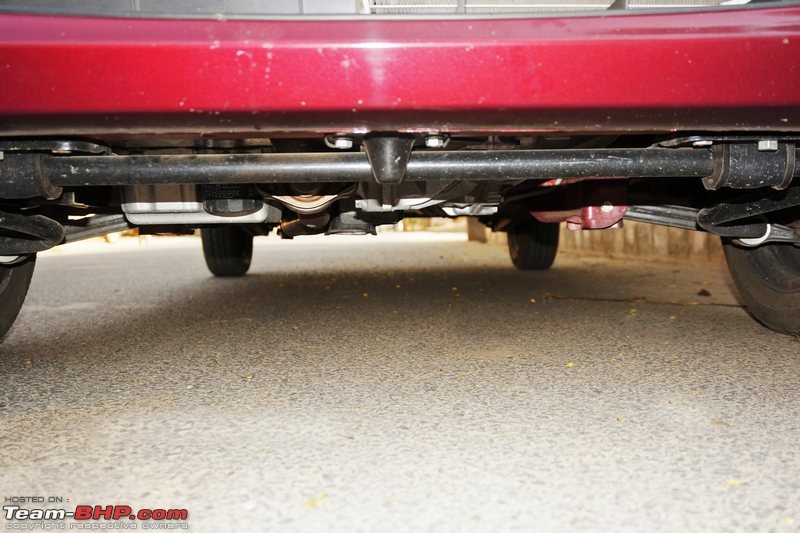 Last edited by GTO : 4th December 2014 at 11:57. |
| |  (10)
Thanks (10)
Thanks
 |
| The following 10 BHPians Thank S2!!! for this useful post: | Abhi_abarth, Chethan B G, GTO, manij, Rambo-RS, S.MJet, Technocrat, theexperthand, V.Narayan, wishnipon |
| | #7 |
| Senior - BHPian Join Date: Mar 2008 Location: Mumbai
Posts: 1,918
Thanked: 10,064 Times
| Maruti Alto K10 : Official Review Other Points: • Rattles are part of standard equipment. Both our test cars (MT & AMT) had some rattles from the doors. These examples had <2,000 kms on the odometer! • The ol' Alto K10 was priced between Rs. 3.15 - 3.28 lakhs while the 2014 car is priced between Rs. 3.06 - 3.56 lakhs (petrol manual only). 28K more on the top variant gets you an airbag, remote-key entry, integrated music system and more modern exteriors & interiors. • Maruti has sold over 26 lakh units of the Alto (800 + K10) till date. • Will be built at the Gurgaon factory, alongside the Alto 800, WagonR, Eeco, Omni and Gypsy. • An optional CNG variant is available on the Alto K10. It's equipped with a 60 liter gas tank (located in the boot), over & above the 35 liter petrol tank and has an efficiency rating of 32.26 km/kg. In CNG mode, the Alto produces only 58 BHP @ 6,000 rpm and 78 Nm of torque @ 3,500 rpm, while the kerb weight of the car is higher @ 835 kgs. This results in a power-to-weight ratio of merely 69 BHP/ton & 93 Nm/ton. Important to note that the Alto K10 CNG is categorised as a 4-seater (not 5 like the petrol). The CNG variant is pricier by Rs. 60,000 and only available in the LXI trim level. • Theoretically, with a 35 liter petrol tank and an ARAI mileage of 24.07 km/l, the K10 can achieve a range of 842 kms! Even if the li'l car delivers 16 - 17 km/l on the highway, it offers a healthy tank range of 560 - 600 kms. • The AMT is available in a single trim - the VXI and carries a premium of Rs. 43,000 over the MT. • The base LX variant doesn't make sense at all, as it lacks even power steering. What it does very well is attract buyers to the K10 over the Alto 800. • The AMT is the 4th type of Automatic to be offered in India, after the traditional torque-converter type, dual-clutch AT & CVT. • The Alto K10 is Maruti's 2nd AMT-equipped model after the Celerio. Soon, the WagonR in its Stingray avatar will feature an AMT (related news). • 40% of Celerio sales came from the AMT transmission. How will it be for the Alto K10? Maruti predicts the percentage will be lower (related link). • Maruti is working with Magneti Marelli to increase the monthly AMT production from 3,500 to 5,000 units by January 2015. The company expects Magneti Marelli to further increase production levels once it sets up a manufacturing facility at Manesar, Haryana. • Interiors get a single cabin lamp at the front. A more central location on the roof (above the front seats) would have been practical. • 6 colour options to choose from - Tango Orange, Granite Grey, Cerulean Blue, Firebrick Red, Silky Silver and Superior White. • The Alto K10 will be exported to markets in Latin America and Africa. • A huge shoutout to Talented Moderator Stratos for post-processing all the review pictures. Last edited by GTO : 4th December 2014 at 11:48. |
| |  (15)
Thanks (15)
Thanks
 |
| The following 15 BHPians Thank S2!!! for this useful post: | Abhi_abarth, BaCkSeAtDrIVeR, Chethan B G, fiat_tarun, GTO, InControl, manij, NetfreakBombay, Rambo-RS, S.MJet, Shreyas Hande, swiftnfurious, Technocrat, theexperthand, wishnipon |
| | #8 |
| Senior - BHPian Join Date: Mar 2008 Location: Mumbai
Posts: 1,918
Thanked: 10,064 Times
| Maruti Alto K10 : Official Review The Smaller yet Significant Things: Standard key for all variants, except the VXI (O) which gets a remote-key: 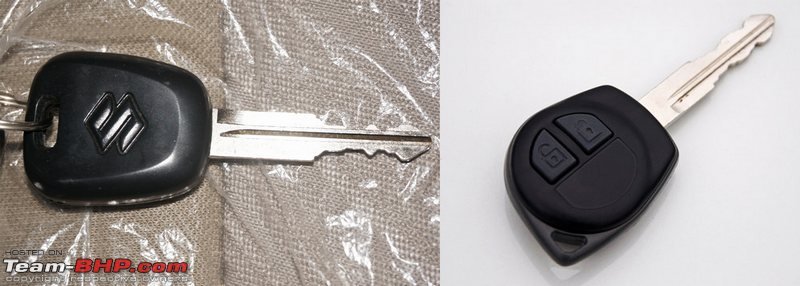 Pull-type antenna is reminiscent of the 90s! Its operation was hard too. Should hopefully get smoother with use:  Key hole on the passenger door as well! Not a big deal, but many manufacturers skip this feature (Alto 800 doesn't have it either):  With the glovebox open, you'll notice all the exposed wires inside (due to the large gap):  The dashboard & instrument cluster backlighting is in orange:  Ill-fitted bonnet opener feels very flimsy:  Seatbelt holders are nicely hidden away in an interior panel. Mahindra (Scorpio) learn something! Not adjustable for height:  All screws on the inside are exposed. Grey carpet will be easy to maintain. That said, the colour doesn't go well with the black & beige interiors. The Alto 800's black carpeting would've looked better (image link):  2 rubber bushings on the parcel tray to prevent rattles:  LX & LXI variants come with different seat upholstery. There's no mention of this in the brochure though:  Seat fabric isn't properly fitted:  Extra H4 headlamp bulbs provided:  RFID tag on the windshield. Authorities have begun using these as an identifier of vehicles & their data:  All tools are tucked away next to the spare wheel. Forget a proper holder, they're wrapped in plastic!  The petrol Alto K10 has a PSI recommendation of 35 while the Alto CNG has it at 32 PSI:  None of the 3 grab handles have a coat hook: 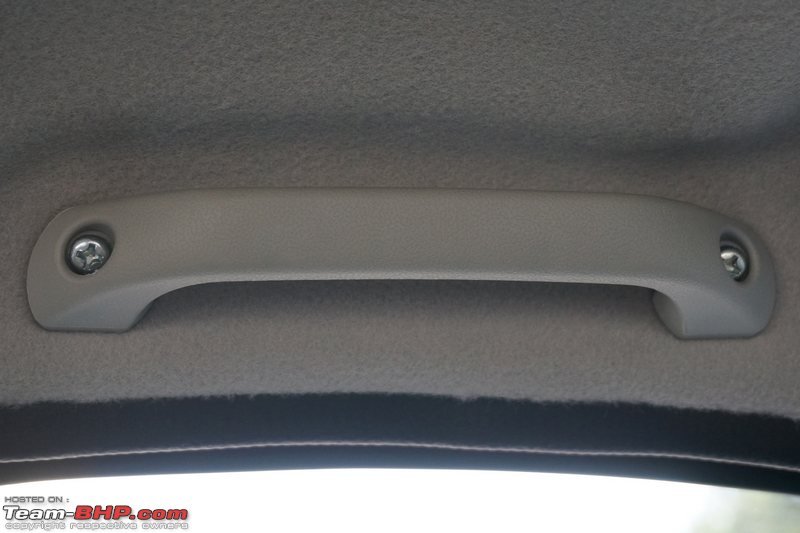 Last edited by GTO : 4th December 2014 at 11:53. |
| |  (15)
Thanks (15)
Thanks
 |
| The following 15 BHPians Thank S2!!! for this useful post: | BaCkSeAtDrIVeR, GTO, humbleroadster, InControl, jassi_jeeper, manij, Rambo-RS, Reinhard, S.MJet, Shreyas Hande, Technocrat, The Great, theexperthand, Viju, wishnipon |
| | #9 |
| Senior - BHPian Join Date: Mar 2008 Location: Mumbai
Posts: 1,918
Thanked: 10,064 Times
| Re: Maruti Alto K10 : Official Review What you’ll like: • Great looking, modern design for 3 lakhs. Makes other budget cars look outdated • Best-in-class interior quality, fit & finish. Excellent air-conditioner too • Many segment first features (tilt steering, gear indicator etc.) • Frugal 3 cylinder petrol engines deliver high fuel efficiency • Big 215 liter boot has a practical layout • Hyundai's excellent after-sales service What you won’t: • 0.8L engine's shaky, vibrating gear lever at all speeds. Overall NVH is unimpressive • Pricing is too close to other 4 cylinder hatchbacks (including the Santro). Top variants overpriced @ 4 lakh • 0.8L engine doesn't really impress in any particular area • Steering is too light & sensitive at highway speeds • Hyundai's service costs are usually higher than that of the competition Datsun Go What you'll like: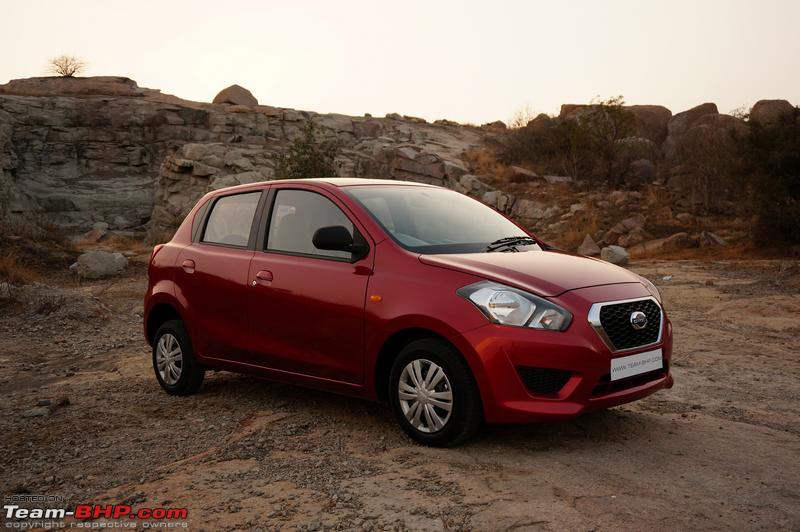 • Clean, inoffensive styling that will please all & offend none • The Go is a size bigger than its direct competitors. Evident on the inside & outside • 1.2L engine results in the segment best torque-to-weight ratios • Urban ride quality is superior to most other entry level hatchbacks • Light driving controls & small turning radius make it well suited as a city car • Large 265 liter boot is very accommodating • Features such as follow me home headlamps, full MID & speed-sensitive wipers What you won't: • Cost cutting is obvious, especially with the interiors • Too noisy. Overall NVH levels are rather poor • Datsun is an unknown brand & Nissan's after-sales service is substandard • No ABS or Airbags offered on any variant. Fared poorly in recent crash tests too • Awful 155 mm Strada brand Tyres • The Micra Active is close, especially from an EMI perspective • Missing essentials (glovebox lid, retractable rear seatbelts, ORVM adjustment stalk, day/night IRVM, proper head-unit) What you’ll like: • A much improved Alto at the same price point • F8D engine has excellent driveability & fuel economy. Neat gearshift too • Comfortable ride quality. Soft suspension is absorbent • Convenient city car: Light, agile & easy to drive • Effective air-conditioner • Driver-side airbag & factory fitted CNG kit available • Maruti's excellent after-sales service & fuss free ownership experience What you won’t: • Cramped rear bench. Also, the seatback is very short • Thin, budget seats offer basic levels of support • CNG kit for base variant costs a hefty Rs. 75,000 (LXi's CNG kit is a realistic Rs. 57,000) • Poor outright performance. Mediocre expressway handling. Best driven <100 kph • Puny 145 mm tyres. An upgrade is highly recommended • Lacks the design appeal of the Hyundai Eon • Fared poorly in recent crash tests Hyundai Santro What you’ll like: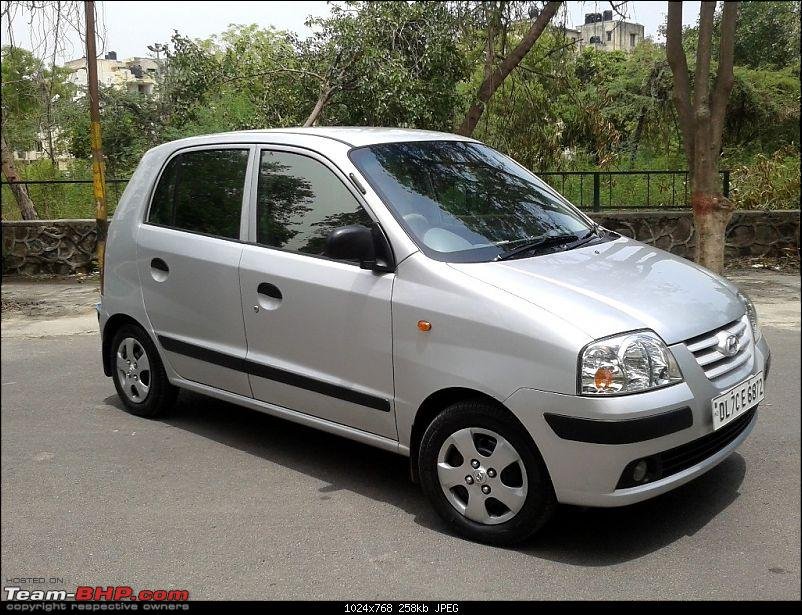 • An all-rounded urban hatchback • Torquey and fuel-efficient engine • Tall-boy benefits such as easy ingress, extra head-room etc • High quality interiors • Excellent Hyundai service What you won’t: • Outdated. Long in the tooth now • Lackluster highway performance • Bumpy ride quality • Hard compound seats Chevrolet Spark What you’ll like: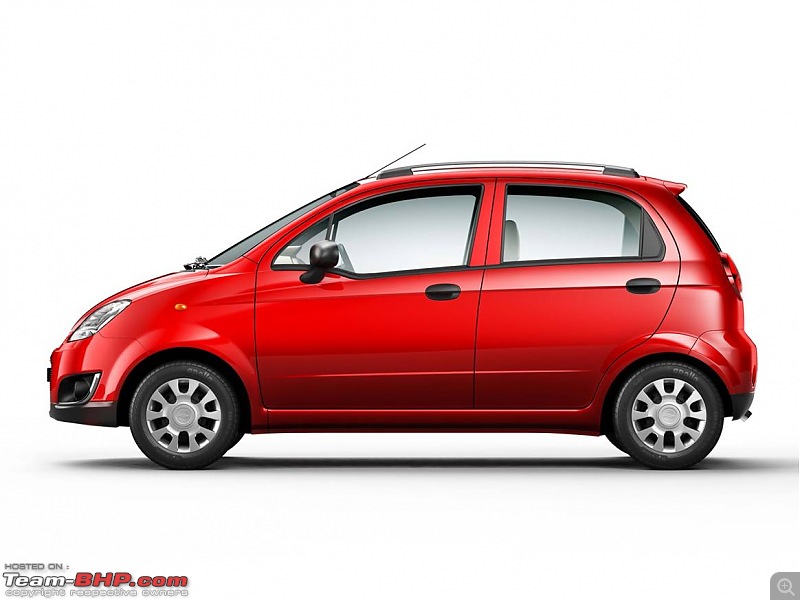 • Cheeky and youthful styling • Good build quality • Fuel-efficient engine • Balanced ride and handling package • Fun to drive nature What you won’t: • Feels terribly outdated • Overpriced for what it offers. Fresher competition is cheaper • Dull interiors • Lack of rear bench space • Inconsistent GM service Maruti WagonR What you'll like: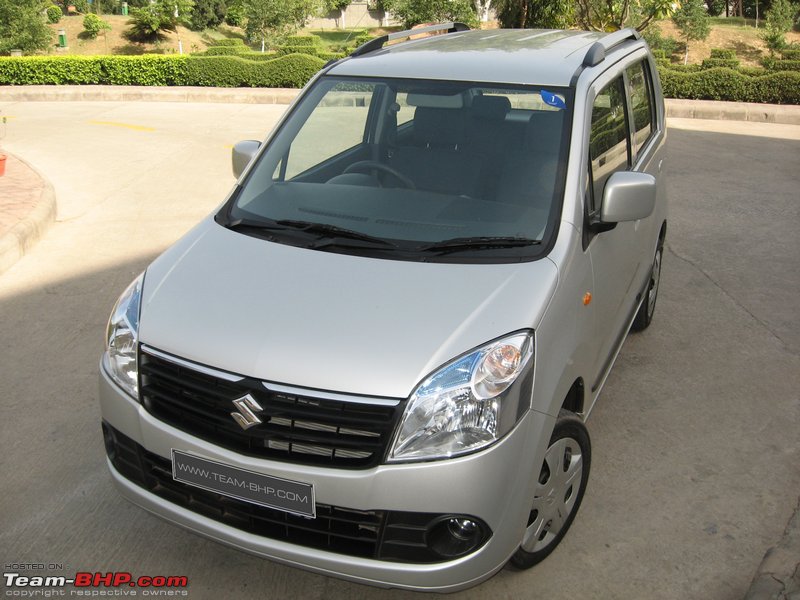 • A practical value-for-money package • Improved road manners, especially urban ride quality • Improved interior space • Precise gearshifts, unlike the older lousy transmission • Optional ABS & Dual Airbags on the VXi variant • Available in LPG and CNG variants too • Maruti's stellar after-sales quality & network What you won't: • Higher NVH levels, inherent to 3 cylinder engines. Average low rpm throttle response • Iffy build & interior part quality • Smaller boot compared to the outgoing gen. 180L capacity • Looks aren't as contemporary as other recent launches Last edited by GTO : 4th December 2014 at 14:43. |
| |  (17)
Thanks (17)
Thanks
 |
| The following 17 BHPians Thank S2!!! for this useful post: | Abhi_abarth, GTO, jassi_jeeper, JLS, manij, maximus., pyrodrive, S.MJet, Shreyas Hande, swiftnfurious, Technocrat, The Great, theexperthand, Viju, whitewing, wishnipon, yajaman99 |
| | #10 |
| Distinguished - BHPian  | Although all of my observations have been mentioned in the review here, i'd like to emphasize on a few points- If you have the budget don't think twice buy a Celerio/Wagon-R over it. The compromises here are too serious. Firstly, the K series engine with poor quality mounts and close to zero insulation has high NVH and constant vibrations similar to Alto 800 have to be constantly tolerated. If you are not going to high revv this engine, buy the 800 instead, because it is only close to the top end the difference in smoothness and rev happiness is clearly evident. You will not be able to enjoy the extra horsepower due to the nervous handling, even though the agile and flick-able handling is enjoyable to a certain extent but it does not warn you when approaching the limit, and that happens quite early. Straight line stability at speed is worst for any car i have driven, at speed slightest gentle input to the steering is good enough send shivers down to your spine. I feel in case of emergency evasive maneuvers this car is going to be uncontrollable even for experienced drivers. We tested it on other car (this time AMT), it was equally scary. In pursuit to deliver tall FE figures, the weight had to kept low, and the only way to do that in this budget range is compromise in the structure. Not only panels feel paper thin, the joints and gaps just do not convey the confidence. Furthermore, it shares the chassis with the infamous Alto 800, which structure collapsed awfully in the recent crash tests. Now the good part- AMT works well, for light accelerator inputs it almost behaves like a conventional Automatic, just that the shifts take long time but they remain smooth, the shift logic is well sorted, unlike the older torque convertor automatics you do not have to remind the box to upshift/downshift. Once you get used to the AMT transmission you use it to extract decent amount of performance on open roads. This car even in AMT guise can keep up far more expensive cars on the highway(of course, i wouldn't recommend doing this). The only disappointment is the unusually long time taken to execute the gearshifts especially gets annoying when you try to extract some performance from this car. But overall what's going to matter the most here considering the segment of this car is the fact that there is close to zero amount of compromise on fuel consumption part compared the Manual transmission equipped variant. If you have ever driven the incredibly smooth K Series Swift/Ritz Petrol, do not let the K series moniker on the Alto K10 raise your expectations, there is not even fraction of that smoothness here, especially in the low end and mid range. Last edited by GTO : 6th December 2014 at 12:21. Reason: Moving your post to the opening page |
| |  (9)
Thanks (9)
Thanks
 |
| The following 9 BHPians Thank .anshuman for this useful post: | aditya101, Chethan B G, GTO, InControl, Leoshashi, maximus., S2!!!, Shreyas Hande, Viju |
| | #11 |
| Distinguished - BHPian  Join Date: Aug 2011 Location: Bangalore
Posts: 4,606
Thanked: 17,682 Times
| Re: Maruti Alto K10 : Official Review Excellent, well detailed review. It is amazing to the see the progress and popularity of AT's over the last year in India. It required India's top manufacturer to do something to promote AT's and they did just that. Who would have thought that India's top selling car would get an AT version. |
| |  (2)
Thanks (2)
Thanks
 |
| The following 2 BHPians Thank Rajeevraj for this useful post: | .anshuman, GTO |
| |
| | #12 |
| BHPian Join Date: Feb 2012 Location: Navi Mumbai
Posts: 670
Thanked: 1,182 Times
| Re: Maruti Alto K10 : Official Review Thanks S2 for an excellent detailed review as usual. I am impressed with the overall dash design & layout. Black & beige color scheme gives an up-market feel. Steering wheel, speedo, RPM meter dials looks & feels good as well, a very welcome change from the old design. Maruti has set the trend of affordable automatics in India and once Magneti Marelli establishes production here IMO customers will have lots of budget/small cars with AMT to choose from. |
| |  (2)
Thanks (2)
Thanks
 |
| The following 2 BHPians Thank S.MJet for this useful post: | GTO, S2!!! |
| | #13 | |
| BHPian Join Date: Oct 2013 Location: Hyderabad
Posts: 628
Thanked: 326 Times
| Re: Maruti Alto K10 : Official Review Quote:
Pick up a very thin piece of metallic sheet, put in a decent performance engine and voila you get a fast, peppy and a fuel efficient car. Who cares about the safety of the passengers.  On other note, Alto K10 is used as cabs on hills. Manali stretch is full of K10 cabs. Surely because of a great Power-to-Weight ratio, making it a hill climb friendly ride. Isn't the santro out of the market now? Last edited by ank.nsit : 4th December 2014 at 16:42. | |
| |  (1)
Thanks (1)
Thanks
 |
| The following BHPian Thanks ank.nsit for this useful post: | GTO |
| | #14 |
| Senior - BHPian Join Date: Oct 2008 Location: Pune
Posts: 1,931
Thanked: 3,825 Times
| Re: Maruti Alto K10 : Official Review Excellent detailed review. Will definitely help future buyers. I agree with your opinion fully, that 'More accomplished WagonR & Celerio are priced not too far away'. I tried K10 and celerio back to back, and unless it is too impossible to extend the budget, I will definitely suggest to go for Celerio AMT. It's big, and driver doesn't rub shoulders with the co-passanger. But this car is a very good step towards promoting AMT. I didn't see Alto800 much in cities, but in villages, I saw them packed to the brim! I hope this Alto1000 AMT too catches up in sales. |
| |  (1)
Thanks (1)
Thanks
 |
| The following BHPian Thanks ani_meher for this useful post: | GTO |
| | #15 |
| BHPian Join Date: Jul 2014 Location: Pune
Posts: 33
Thanked: 19 Times
| Re: Maruti Alto K10 : Official Review Review is top class with all features that we need to know Maruti has done a good job with this car as it does not look ugly as the other versions of alto and celerio. The only thing I found missing is the absence of AMT in the LXI version. |
| |  (1)
Thanks (1)
Thanks
 |
| The following BHPian Thanks Nats for this useful post: | S2!!! |
 |


